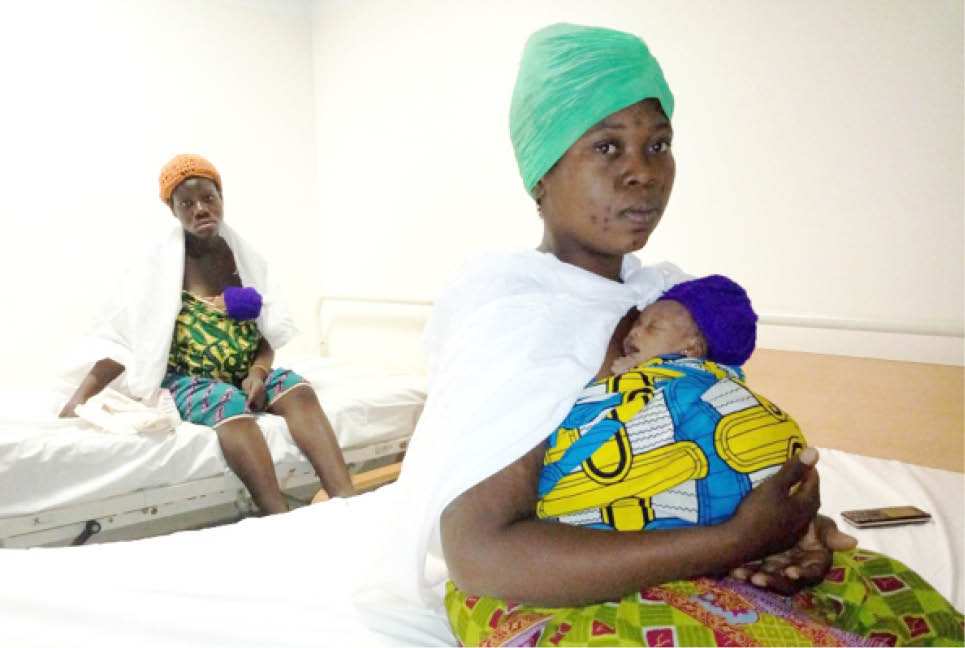Hypothermia: Kangaroo care to the rescue
In low resource settings, hypothermia in newborns is regarded as an important contributor to neonatal deaths. Kangaroo care is a method caregivers can use to keep newborns warm, alive and thriving. Mothers and their newborns strapped to their breasts in colourful wax wrappers which served as kangas, filled the Kangaroo Mother Care (KMC) unit at […]

In low resource settings, hypothermia in newborns is regarded as an important contributor to neonatal deaths. Kangaroo care is a method caregivers can use to keep newborns warm, alive and thriving.
Mothers and their newborns strapped to their breasts in colourful wax wrappers which served as kangas, filled the Kangaroo Mother Care (KMC) unit at the Regional Hospital Tamale, Ghana.
The sight of them also provided the perfect picture as some who had twins, tried with the aid of the nurses to strap both babies, securely, with rapt attention.
Some of the women had been delivered of their babies, only a few hours before our reporter visited. They were being taught how to strap the newborns onto their bodies to keep the children warm and their body temperatures on the right level to prevent them from suffering hypothermia.
According to the World Health Organisation (WHO), hypothermia occurs when the body temperature drops below 36.5°C (97.7°F). This is the lower limit of the normal range of 36.5-37.5°C (97.7-99.5°F).
The global health body adds that it raises concern when the temperature of a newborn is between 36.0-36.4°C (96.8-97.5°F), which may be due to cold stress.
While all babies may suffer cold stress leading to hypothermia, preterm babies are more susceptible because they lose body heat more easily, putting them at risk of life-threatening medical emergency.
Kangaroo Mother Care is helping to keep it in check, in low resource settings.
The WHO describes KMC, which is also called skin-to-skin contact, as one involving the baby being strapped bare skin to its parent’s chest – usually its mother’s – in a way that provides skin-to-skin contact, generating warmth in the process to increase and stabilise the child’s temperature.
In Nigeria, KMC became popular in the late 90s to early 2000s following the visit of Dr Edgar Rey and Dr Hector Martinez of the Instituto Materno Infantil in Bogota, Colombia. The medical doctors first proposed the practice in 1978 and encouraged it in hospitals across Nigeria, being a low resource setting, where incubators are scarce and/or parents cannot afford the cost, for their newborns.
At the Tamale hospital, which is one of the government-run health facilities, mothers with newborns are generally encouraged to practice KMC and more so when their babies are preterm or suffer hypothermia. At a unit dedicated to KMC, the mothers are taught how to wrap the babies onto their bodies.
For Rose Basaking, who had been delivered of twins a few days before our reporter visited the hospital, learning to wrap them both to her breast took several lessons and some dexterity. In the end, “I learnt how to do it,” she said excitedly.
“It took me eight years to have them so I am learning everything that I need to, to ensure they stay healthy,” she told our reporter.
Although she had been safely delivered of the babies, she was back in hospital because they were anaemic. Notwithstanding, the new mum said, “the nurses taught us not to wait until the children have a problem before we practice KMC because it also helps us bond with them, when we do it.”
Dr. Dalhatu Afegbua, a Senior Registrar at the Department of Paediatrics, Federal Medical Centre Azare, Bauchi State, said KMC is a very effective method of treating hypothermia and mothers are highly encouraged to adopt it as a treatment method. He however said the decision to use KMC is heavily dependent on the cause of the hypothermia in the first place.
He said, “Where the cause of hypothermia is infection and especially if it is severe, then other more advanced treatments are used. These could vary from gastric lavage commonly called stomach pumping which involves pumping warm water into the stomach of the child to increase body temperature. The child could also be kept in an incubator and given warm feeds, among other methods.”
Findings of a 2009 research on neonatal hypothermia, led by Vushal Kumar of the Himachal Pradesh University, India, said hypothermia is increasingly recognized as a major cause of neonatal morbidity and mortality in resource poor settings with high prevalence reported widely from warmer high mortality regions of Africa and South Asia.
The study also said hypothermia remains under-documented, under-recognized and under-managed.
Newborn stakeholders reached a consensus at the 2013 KMC acceleration meeting in Istanbul, Turkey. They agreed that based on available evidence, KMC should be adopted and accelerated as a standard of care and an essential intervention for preterm newborns.
As part of an integrated reproductive, maternal, newborn and child health package, the forum targets to achieve 50% coverage of KMC among preterm newborns come 2020, on global and national levels. It was also agreed that with universal coverage, KMC could prevent close to 531,000 preterm deaths every year by 2025.
In Ghana, antenatal, maternal and newborn care is free for one year and mothers are exempted from paying the (low) national health insurance. This encourages mothers like Basaking to patronise the regional and other government hospitals as often as they need to and be confident of receiving quality care.
Regardless what the case may be, Afegbua stresses that it is important to first ascertain the cause of the hypothermia in the newborn before a treatment plan is employed.
